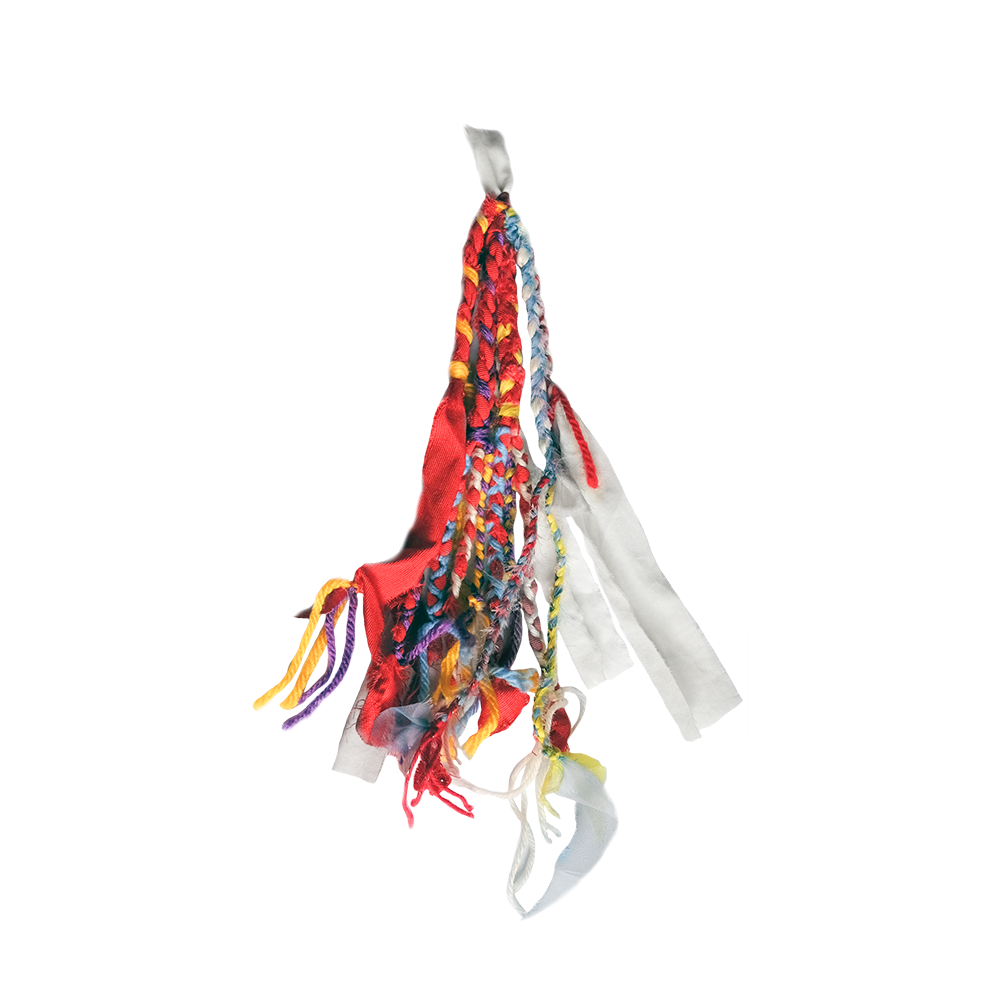
BRAIDED FIRE 1, SCULPTURE, 1.7 METERS HIGH BY 1.2 METERS WIDE
PROJECT:
Braided Fires
EVERYWHERE
SCULPTURE
W.I.P
2023
Braided Fires
EVERYWHERE
SCULPTURE
Old scarves, reused wool, cashmere, cotton, acrylic, leftovers, wood
W.I.P
2023
The Fates, Talking Heads, Ball de bastons, Ram Dass, Algorithms and Molotov cocktails.
As a child, I used to braid often, which was the only manual skill I had developed with fabrics. Now, everywhere I go, I braid fires. Some take on a human scale –bonfires and barricade fires–, while others are of medium size, resembling hearth fires. Others are small glowing embers I post to my friends for the winter solstice.
Fire inspires. It warms, cooks, destroys, lights up, has a main role in protests and riots, and presents change in life. It is an aesthetically mobile element and a versatile technology, deeply spiritual.
In spending time with these pieces, while braiding them, I found a thread to my own upbringing. How odd it is to reconnect with myself during this process that is familiar with childhood, situated in the present times yet rooted in the past –my personal past and the past of many women in different locations of the planet. I had expected to find something new, but instead, I found explanations for something old.
These works are created by hand, take time and are physically demanding. I have been braiding recycled materials and clothes that are considered waste. I collect leftovers from yarns and fabrics in nearby ateliers and from friends who make costumes and film props. Old broken scarves and blankets. Warm natural materials: most of the fibres are wool and cashmere, cotton and linen.
In the act of braiding, I find meditation. Trouble goes in to express beauty out. When I assemble many braids they form a sculpture that archives many stories. We chat while we braid like our grandmas did while they were weaving together. The repetition of gestures frees our minds because our hands are thinking.





EMBERS

BRAIDED FIRE 3, SCULPTURE, 1.2 METERS HIGH BY 0.8 METERS WIDE
Lately, I have been thinking and writing about what braiding does, and discovered braiding as method.
Braiding implies repetitive motion. In this rhythmic flow, while we braid, we focus our attention on the present moment, follow tactile sensation, sentipensamos –mind and body reconnect, our hands think. Braiding enacts a cathartic release of energy. This tension is passed to the braided material and the material will contain it forever.
Each braid tells a dividual story. A braid is a tangible record of a narrative, its encoded symbolism serves as a form of communication across time. Braids can function as archives in a metaphorical and a physical sense. They embody and preserve cultural traditions, personal events or historical connections. But they can also serve as archives by encapsulating these messages through the energy of each gesture.
The act of braiding becomes a dynamic form of archiving that weaves together diverse threads of identity. Materials hold memory and significance. Whether using specific fibres and colours, the materials woven into braids contribute to the material culture of a particular time and place. Braids are, formally and energetically, time capsules.
When we learn and practice braiding, links are established between the past and present. The transmission of knowledge through braiding fosters intergenerational connections, both contemporary and non-contemporary, between us and us. The act of braiding becomes a dynamic form of archiving that weaves our diversities, it makes the interconnectedness obvious. In each gesture, with our hands, we pass the energies composing our dividual stories. By losing the ‘in’ in individual we acknowledge a borderless way of existing –or a braided way of co-existing–, the inclusive interconnectedness. All experiences, alone or collective, human and non-human, are shared experiences.
When we braid together many hands are thinking in physical proximity. We are close to one another, we can connect our braids, entangle them, braid the braids, and we might find intimacy in these algorithms. The unhurried nature of braiding provides relaxed opportunities for conversation, where shared histories can be formed, enhancing the sense of connection, correlation and understanding between dividuals.

DETAIL OF BRAIDED FIRE 1